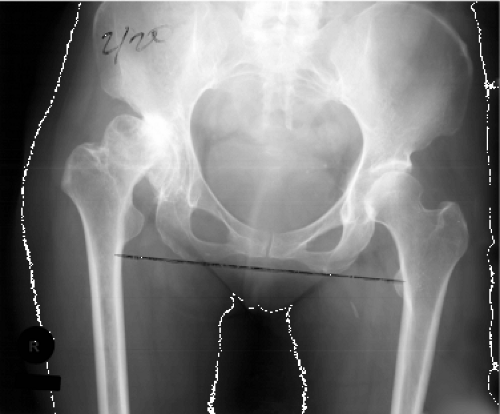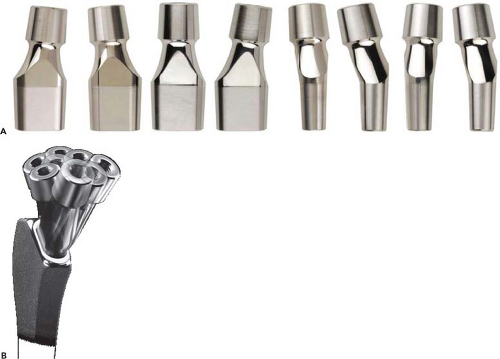Modular Neck Cementless Femoral Components
Bradley L. Penenberg
Antonia Woehnl
Mathew D. Schur
Case Presentation
A 71-year-old female presents with increasing right hip pain, limp, and decreasing ambulatory function. Radiographs reveal femoral head subluxation and near dislocation with a shallow upsloping acetabulum (Fig. 57.1). There is marked narrowing of right hip joint, bony sclerosis, cyst, and osteophyte formation. There is limb shortening with reduced femoral offset. This woman has advanced osteoarthritis (OA) superimposed upon developmental hip dysplasia (DDH).
This case presents a number of reconstructive considerations. Apart from the obvious deformities, as one plans the operative procedure, it is essential to understand the anatomy of DDH. There is clearly a shallow socket that requires careful and precise reaming and cup positioning. There is also the less obvious, but very significant issue of excessive femoral anteversion. If not adequately addressed at surgery the hip is likely to be unstable. It is generally reported that femoral anteversion in DDH patients is on average 10 to 14 degrees higher than in nondysplastic hip patients. In nondysplastic patients, the femoral anteversion typically ranges from −15 degrees (retroversion) to +30 degrees, while DDH patients have a reported range between 0 and 90 degrees with an average of 35 to 65 degrees (1,2,3,4). This anatomical factor has to be reconciled with the fact that the generally accepted range of combined anteversion for total hip arthroplasty (THA) is 25 to 60 degrees (5,6,7,8,9). To some extent the excessive femoral anteversion in DDH can be compensated for by reduced acetabular anteversion. There will be a limit to the amount of “under-anteversion” that will be possible. This limit is presented by the bony anatomy. As the cup is increasingly retroverted there is risk of its anterior edge protruding past the anterior rim of the acetabulum. This can lead to painful iliopsoas tendon impingement. Conversely, posterior impingement can occur as the posterior wall becomes a potential point of contact for the posterior edge of the greater trochanter. Therefore, if the acetabular component could be placed in neutral, for example, then perhaps femoral anteversion up to 40 to 50 degrees could be tolerated. But what if the hip is still unstable? The surgeon must be prepared for the situation where reduced acetabular anteversion will not compensate for excessive femoral anteversion. Since the ability to reduce anteversion by derotating the femoral component within the canal is very limited, a modular neck can provide the ability to further adjust the center of the femoral head.
Introduction
Original Purpose of Modular Neck Femoral Components
A successful THA can be defined as a hip in which “balance” has been restored, pain has been relieved, and the patient has returned to normal function with implants that are positioned within accepted parameters. We consider balance to have been restored when we have placed the prosthetic hip center as close to the original as possible as measured by relative limb length and offset. In order for the patient to experience satisfactory range of motion (ROM) and not suffer
dislocation, additional conditions must be met. An appropriate amount of combined anteversion is another critical parameter for successful functional outcome and maximum implant longevity after THA. Satisfactory combined anteversion of the acetabular and femoral component must be present to avoid impingement, which can result in not only dislocation, but also clicking or unnatural “toeing-in” (with excessive combined anteversion) while walking as well as edge loading and early implant wear. The recommended combined anteversion to avoid dislocation, achieve optimal ROM, and increase implant longevity is described with 25 to 60 degrees (5,6,7,8,9). Combined anteversion has been shown to be lower in men (25 to 35 degrees) and higher in women (35 to 45 degrees) (6), and a combined anteversion of 37 degrees was reported to be beneficial to avoid impingement (9). To restore the optimal hip center and achieve optimal hip function and stability each patient needs a different combination of version and offset. In certain cases this can be challenging to achieve with conventional fixed neck components. Modular neck femoral components were developed in 1985 to address this issue. They can facilitate the restoration of the hip center during THA by providing the opportunity to independently adjust certain parameters. Introduced by Cremascoli (ANCA-Fit, Milan, Italy), modular necks gained worldwide popularity in THA with several hundred thousand implanted since 1985. At the time of their development conventional fixed neck implants did not provide the surgeon with the same versatility as they currently do, now nearly 30 years later. The fixed neck options were restricted to a neck–shaft angle of 135 degrees, or in some cases 137 degrees, and had no offset options. A few designs over the last two decades offered an anteverted neck (e.g., Howmedica, PCA, and DePuy Prodigy) but permitted limited combinations of femoral version, offset, and implant size. Most systems only offered increasing offset as the bodies became larger. On the other hand, modular components offered the possibility to expand the ranges of femoral implant orientation by addressing these parameters independent of stem geometry. Depending on the manufacturer, a modular neck can offer up to 60 different head center positions, in the sagittal, transverse, and coronal planes (Fig. 57.2A,B). This clearly provides greater intraoperative versatility than conventional fixed neck components that provide approximately 10 different options per stem size to configure femoral version, offset, and limb length. Modular necks have been shown to be beneficial in patients with an extremely anteverted or retroverted native femoral neck. A fixed neck implant may not be able to create the same femoral version as the patient’s original anatomy (10). To optimize combined anteversion in these patients the anteversion of the acetabular cup would need to be increased or decreased to compensate for the neutral version of a fixed neck femoral component. There is limited opportunity to influence the
anteversion of a press-fit femoral component, whereas modular neck femoral components provide the surgeon with greater flexibility to recreate the center of the femoral head and restore native hip biomechanics (11,12). Studies have shown efficient adjustments of femoral anteversion and offset in patients who presented with a natural femoral anteversion of over 30 degrees (13,14), and adequate ROM was shown to be achieved using modular necks even with femoral anteversion of up to 60 degrees (15).
dislocation, additional conditions must be met. An appropriate amount of combined anteversion is another critical parameter for successful functional outcome and maximum implant longevity after THA. Satisfactory combined anteversion of the acetabular and femoral component must be present to avoid impingement, which can result in not only dislocation, but also clicking or unnatural “toeing-in” (with excessive combined anteversion) while walking as well as edge loading and early implant wear. The recommended combined anteversion to avoid dislocation, achieve optimal ROM, and increase implant longevity is described with 25 to 60 degrees (5,6,7,8,9). Combined anteversion has been shown to be lower in men (25 to 35 degrees) and higher in women (35 to 45 degrees) (6), and a combined anteversion of 37 degrees was reported to be beneficial to avoid impingement (9). To restore the optimal hip center and achieve optimal hip function and stability each patient needs a different combination of version and offset. In certain cases this can be challenging to achieve with conventional fixed neck components. Modular neck femoral components were developed in 1985 to address this issue. They can facilitate the restoration of the hip center during THA by providing the opportunity to independently adjust certain parameters. Introduced by Cremascoli (ANCA-Fit, Milan, Italy), modular necks gained worldwide popularity in THA with several hundred thousand implanted since 1985. At the time of their development conventional fixed neck implants did not provide the surgeon with the same versatility as they currently do, now nearly 30 years later. The fixed neck options were restricted to a neck–shaft angle of 135 degrees, or in some cases 137 degrees, and had no offset options. A few designs over the last two decades offered an anteverted neck (e.g., Howmedica, PCA, and DePuy Prodigy) but permitted limited combinations of femoral version, offset, and implant size. Most systems only offered increasing offset as the bodies became larger. On the other hand, modular components offered the possibility to expand the ranges of femoral implant orientation by addressing these parameters independent of stem geometry. Depending on the manufacturer, a modular neck can offer up to 60 different head center positions, in the sagittal, transverse, and coronal planes (Fig. 57.2A,B). This clearly provides greater intraoperative versatility than conventional fixed neck components that provide approximately 10 different options per stem size to configure femoral version, offset, and limb length. Modular necks have been shown to be beneficial in patients with an extremely anteverted or retroverted native femoral neck. A fixed neck implant may not be able to create the same femoral version as the patient’s original anatomy (10). To optimize combined anteversion in these patients the anteversion of the acetabular cup would need to be increased or decreased to compensate for the neutral version of a fixed neck femoral component. There is limited opportunity to influence the
anteversion of a press-fit femoral component, whereas modular neck femoral components provide the surgeon with greater flexibility to recreate the center of the femoral head and restore native hip biomechanics (11,12). Studies have shown efficient adjustments of femoral anteversion and offset in patients who presented with a natural femoral anteversion of over 30 degrees (13,14), and adequate ROM was shown to be achieved using modular necks even with femoral anteversion of up to 60 degrees (15).
Disadvantages and Complications
Despite good midterm clinical results with effective restoration of hip biomechanics, low complication rates, and survival rates up to 97.5% at 5 to 11 years, the additional junction between neck and femoral shaft that defines modular neck components has the potential for two modes of catastrophic failure not seen with fixed neck or monolithic femoral components (16,17,18,19,20,21,22,23). These failures are fracture or corrosion induced, shedding off particles that can cause adverse local tissue reaction (ALTR). The recall of one popular system is believed to have been the result of fretting and generation of particulate metal debris at the neck–stem junction (24). As with the large metal-on-metal bearings it appears that symptomatic and destructive local tissue reaction can occur and lead to early revision surgery (25). It is beyond the scope of this chapter to analyze the causes of failure, but clearly the performance of these materials over time is multifactorial. When choosing a system, the published clinical results should provide satisfactory guidance as to the safety of a particular system. The additional junction inherent in the modular neck design transmits bending and axial stresses at the neck–shaft junction in a unique manner. This has been linked, in certain systems, to decreased mechanical resistance, causing fretting and crevice corrosion in the “pocket” at the neck–stem junction (26,27,28,29,30,31). This process may lead to increased metal ion release, which can subsequently cause ALTR, aseptic loosening, and early implant failure (13,14,32,33,34,35,36,37,38,39). The Australian National Joint Replacement Registry reported an overall revision rate for modular neck femoral components of 10.8% at 10-year follow-up while fixed neck components had a revision rate of 6.4% (40). Interestingly, these revision surgeries were most often a result of stem loosening or dislocation and least often a result of neck fracture. The use of certain titanium modular necks has been linked to a higher degree of micromotion, which may result in higher surface damage at the neck–stem junction and subsequently lead to higher failure rates in these implants (Figs. 57.3 and 57.4) (41). Due to increased stresses at the neck–stem junction, modular neck fractures are more likely to occur in patients with retroverted necks and in obese or very tall patients with long necks and/or high femoral offset (35,36,42,43,44,45




Stay updated, free articles. Join our Telegram channel

Full access? Get Clinical Tree










